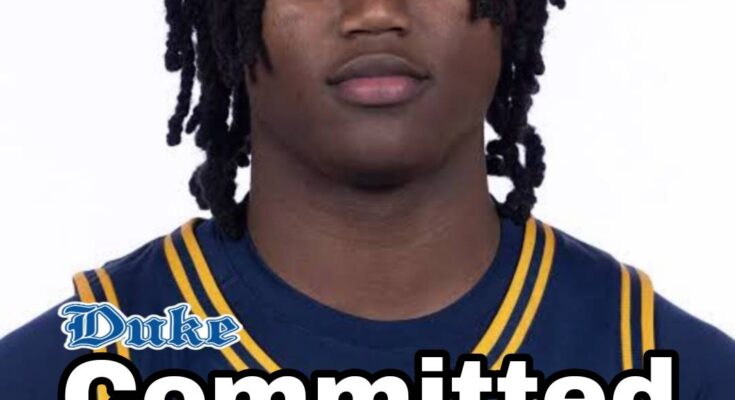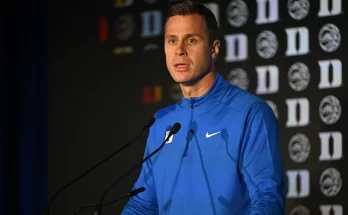The top-ranked American basketball recruit choose Duke over Georgia and Tennessee.
The world of college basketball recruiting is often marked by intense competition, last-minute decisions, and high-stakes drama. In one of the most closely watched recruitments in recent memory, the top-ranked American basketball prospect has officially chosen to take his talents to Duke University, opting for the historic program over strong pitches from the University of Georgia and the University of Tennessee. This decision reverberated through the basketball world, setting the tone for the upcoming NCAA seasons and reaffirming Duke’s perennial status as a powerhouse in both recruiting and player development.
The recruit in question, widely regarded as the number one player in his class, has long been the subject of intense scrutiny and media attention. Standing 6’8” with a wingspan that defies convention and athleticism that makes scouts drool, he has been touted as a future NBA lottery pick since his early high school days. From his freshman season onward, he dominated at the high school level, routinely posting triple-doubles and showcasing a versatile skill set that includes elite scoring, rebounding, passing, and defensive prowess. His highlight reels flooded social media, drawing millions of views and catching the attention of basketball luminaries across the country.
The recruiting battle for his commitment began in earnest during his sophomore year, with blue-blood programs and emerging contenders alike trying to get a foot in the door. However, three programs emerged as finalists—Duke, Georgia, and Tennessee. Each offered something unique. Georgia presented a chance to be a hometown hero, playing in front of family and friends and potentially turning the Bulldogs into a legitimate national force. Tennessee, with its steadily rising basketball profile under head coach Rick Barnes, offered a competitive SEC environment and a system that has recently produced top NBA talent. But it was Duke—armed with a storied history, a lineage of NBA stars, and a coaching staff that blends legacy with innovation—that ultimately won his allegiance.
For Duke, landing this recruit is a testament to the enduring magnetism of their basketball program. Since Coach Jon Scheyer took over the reins from Mike Krzyzewski, there were questions about whether the Blue Devils could maintain their elite status in recruiting circles. Those doubts have been silenced. This commitment not only reaffirms Duke’s ability to lure top-tier talent but also signals to other elite prospects that Durham remains the ultimate stage for preparing for the next level. Scheyer and his staff reportedly built a strong relationship with the recruit early on, emphasizing not only basketball development but also academic support, personal growth, and long-term career planning.
Sources close to the decision-making process say that the recruit was particularly impressed by Duke’s comprehensive development program. More than just a stepping stone to the NBA, Duke offers a platform to grow as a leader, competitor, and teammate. The coaching staff’s attention to detail, combined with a proven track record of getting players NBA-ready within a year, played a pivotal role. While Georgia’s hometown appeal and Tennessee’s rise in the rankings made for compelling alternatives, they couldn’t match Duke’s combination of tradition, exposure, and holistic development.
From a strategic standpoint, his commitment immediately alters the trajectory of Duke’s future roster. The Blue Devils have been known for constructing star-studded teams that blend freshman phenoms with experienced returners. This latest addition gives them a player who can serve as the focal point on both ends of the floor. Offensively, he offers versatility—able to handle the ball like a guard, post up against smaller defenders, and shoot from midrange and beyond. Defensively, his length and quickness allow him to guard multiple positions, block shots, and create turnovers. In the modern game, positionless basketball is king, and he epitomizes that evolution.
The impact of his decision will also ripple beyond Durham. For Georgia, missing out on a homegrown superstar stings deeply. The Bulldogs have struggled to consistently attract top-tier basketball talent, and landing this recruit would have been a transformative moment. Despite recent improvements and increased investment in the program, Georgia must now return to the drawing board. Similarly, Tennessee’s disappointment will be palpable. The Volunteers have built a strong recruiting pipeline and were viewed by many insiders as a real contender until the final weeks. They made a persuasive case built on competitive opportunity and program trajectory, but ultimately came up short.
College basketball fans, analysts, and even rival coaches understand the implications of such a recruitment. The top-ranked recruit choosing Duke ensures that they will remain front-runners in the national conversation. It also sets off a chain reaction in the recruiting world, as other elite prospects now reevaluate their own decisions based on potential teammates and program direction. This is the kind of domino effect that can shape the landscape for years. Duke’s incoming recruiting class now looks even more formidable, potentially placing them as preseason favorites depending on who else joins the fold.
Beyond the hardwood, the NIL (Name, Image, and Likeness) era has added new dimensions to decisions like these. While there is no suggestion that NIL deals played an outsized role in his choice, it’s undeniable that a player of his caliber stands to benefit immensely from Duke’s national profile. Between national television appearances, March Madness exposure, and the university’s marketing reach, he will be well-positioned to build his brand before entering the NBA. His representatives have made it clear that while basketball was the primary focus, long-term opportunities—including NIL—were considered in discussions. This reflects the reality of today’s recruiting landscape, where athletes are entrepreneurs as much as they are competitors.
For fans of the sport, this decision adds even more anticipation to the next college basketball season. Duke games have always drawn massive viewership, but with this star joining the roster, expect ratings to spike and arenas to fill. The hype is justified—not only because of his elite talent but also because of what he represents. He’s part of a new generation of athletes—confident, strategic, and unafraid to embrace the spotlight. His decision was made after careful deliberation, numerous visits, and countless hours of discussion with family, mentors, and coaches. It wasn’t about short-term glory but about crafting a journey that positions him for success at every level.
Recruiting rankings may fluctuate and highlight reels can be misleading, but this player has repeatedly demonstrated that he belongs in the upper echelon of basketball prospects. In summer leagues, high school tournaments, and elite showcases, he has matched up against other top prospects and consistently come out on top. His work ethic, competitiveness, and leadership are often praised as much as his skillset. Coaches rave about his willingness to learn and his adaptability in game situations. In interviews, he has remained grounded and articulate, often crediting his family and coaches for his success.
There’s also a deeper story here about legacy and influence. Duke’s ability to continue attracting the best talent is not just about past championships or NBA alumni—it’s about culture. The Blue Devils have cultivated an environment where elite players thrive, not only statistically but personally. Alumni often return to campus, providing mentorship and continuity. The coaching staff balances discipline with freedom, encouraging players to explore their identities while demanding accountability. This blend of structure and flexibility is part of what convinced this recruit to commit.
Looking ahead, all eyes will be on how he transitions to the college game. The leap from high school to NCAA Division I is steep, and expectations will be sky-high. But if history is any indication, he has the tools to not only meet those expectations but to surpass them. His presence will elevate his teammates, challenge opponents, and energize fans. If all goes according to plan, he could be a one-and-done player, making the jump to the NBA after a dominant freshman year. But even one season in Durham could leave a lasting legacy, inspiring future recruits and adding another chapter to Duke’s illustrious history.
Ultimately, this commitment reaffirms something that college basketball fans already know—Duke remains the gold standard. Despite the evolving nature of the sport, with the transfer portal, NIL deals, and coaching changes redefining traditional structures, some things remain constant. The allure of putting on that Duke jersey, walking through Cameron Indoor Stadium, and competing on the national stage is still potent. For the top-ranked recruit in the country, that was the difference-maker. And for the rest of the basketball world, it’s a clear signal: Duke isn’t just back—they never left.



